Army to upgrade and widen deployments for Nett Warrior
The Army's Nett Warrior hand-held software programmable radio device shows soldiers moving digital maps with icons showing force location information.
The Army is upgrading and rolling out a cutting-edge battlefield force-tracking technology for dismounted soldiers, enabling them to know the locations of their fellow soldiers and more quickly find, identify, target and destroy enemy fighters.
Called Nett Warrior, the technology is a cell-phone-like device showing graphics on a small, digital moving map identifying fast-moving combat information.
“The power of this is to network the soldier,” Lt. Col. Adrian Marsh, Product Manager, Ground Soldier System, said in an interview.
Nett Warrior has greatly helped forward-deployed mobile infantry units who often find themselves in fast-moving firefights with enemy fighters, Marsh said.
“It provides unprecedented situational awareness at the dismounted level through the map display. The icons show where all the other users are on the battlefield, and the device allows for battlefield messaging. Everyone sees the same picture,” Marsh explained. “The battle changes in real time and information can transmit across the force in real time.”
The technology uses a moving digital map display to mark friendly forces, surrounding terrain, enemy forces, targets and other high risk items such as IED locations, Marsh explained.
“As they sweep up into a house, they don’t have to worry about fratricide, because they can see where the other maneuvering forces are. You can track the location of friendly units as you are moving up on a target,” said Jason Regnier, deputy product manager for Nett Warrior.
If a mobile, forward deployed infantry unit were taking an enemy building, for example, Nett Warrior would give them instant information about the location of friendly and enemy forces.
Nett Warrior can even connect with nearby vehicle units who might need to know the location of mobile, ground or infantry units or wish to pass along combat-relevant information, Marsh said.
“Every Nett Warrior display is visible to every other Nett Warrior system. That is the key part. That is the game-changing revolution,” he explained.
While the Nett Warrior device looks like a cell phone or smartphone, it uses what’s called software programmable radio – a technology which sends IP packets of information, such as voice, video and data, across the force using high bandwidth radio frequencies.
The high bandwidth frequencies, such as Soldier Radio Waveform, use computer technology and function like wireless internet. The cell phone function of the system is turned off. The radio, called the Rifleman Radio or PRC-154, uses NSA encryption to safeguard combat information transmitting across the force.
The technology also uses a technique called a “chem light,” so a soldier can highlight or “light up” a location to pass along key information such as the location of a cleared building or other data relevant to an ongoing fight.
“This helps the fight at the platoon level by providing a visual picture or voice instruction about, for example, the location of a house they are going to take down,” Marsh added.
Nett Warrior also uses a chat or messaging function so that soldiers can quickly communicate with one another. Quickly translating from Arabic or Pashtun to English is also an emerging capability of Nett Warrior.
The platform is being built with “open architecture,” to quickly embrace and integrate new technologies or applications as they emerge, such as the addition of field artillery information Marsh said.
---This Story Was Also Published by Scout Warrior---
NEXT STORY: CIA investor backs geospatial data startup





